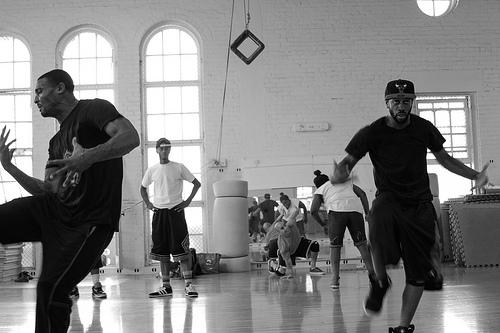An Hour With Krump, And A Newbie Finds It Impossible Not To Feel His Own Pain

Lil' C is a serious man. He is serious about the power of krump — the dance form he helped create and pioneer — and he is serious about the power of art to express and "metamorphosize" pain.
Recently "C" and a group of krumpers performed for journalists and students at the University of Southern California's Kerckhoff Hall. Before the performance, C had pain on his mind. He spoke about how pain was common to all of us, that it purifies.
I thought I knew what he meant. But during the performance, he made his point even more concisely by making me feel my own pain — watching him dance out his. An hour prior, I had never heard of krump, and I had never seen it. Coming to the form so naive, and from starkly different life experiences than these dancers, one might think I would have a hard time accessing it. Instead, it was impossible not to access it. It was there in his movements; raw, cathartic, human.
After the show, C and the other krumpers sat with us and talked about the history of their art form. One attendee asked what they wanted to do with it going forward, now that krump was a worldwide phenomenon. This is what Lil' C had to say:
"We are attempting to perfect the development of a new coping mechanism. We are all from different walks of life ... But the one thing that we share in common is that we all go through some sort of emotional turbulence. And, not having a means of dealing with that, it could eat you — it could just eat away at your soul 'til there is nothing left. And those are the things that cause people to take their lives and even entertain the idea of not even wanting to go anymore, because, you're living this life and it's like, yeah I'm living, but what's the use of living when I feel dead on the inside and I have nothing? I have no voice, I have no means of expressing the pain that I feel, I have no way of emptying out my spam folder. It just says '30,000 emails' and there's no way I can just, empty it all in one sitting.
"This is what krump is. And it goes beyond krump. That's what art is. Art is a way for you to express yourself. It is a way for you to use that negative force that is like an anchor: You got to pull it up, you gotta melt it down and 'metamorphosize' it and turn it into some sort of petroleum to stick in the tank. And that right there should be what you use to push yourself to pursue progression, some form of happiness. And that's what we're doing.
"Because kids today, they don't know how to cope. You know? Nobody's teaching them how to cope because it's the trickle down effect from the parenting and the examples that they see. Like, I know what it feels like to be starving. I know what it feels like to be homeless. That's a heartbreak, that you know — nothing can solve that. And that's going to always be with me. The fact that I know what that feels like. I know what starvation feels like. I know what poverty feels like. Nothing is going to ever be able to rid me of that memory, and it just sits in my brain.
"But the way I cope with it, instead of letting it tear me down and me being ashamed about it, krump and my art is a way for me to be proud of my victory. And the fact that I can find a way to be proud of my struggle. And put my struggles in front of people and show others, you can do this too. It doesn't have to be through dance. It could just be through some form of artistic expression. And that is why I do the things I do.
"I work on a show called 'So You Think You Can Dance.' Some of you may know it, some of you may not. But it's a huge dance show. And I'm the youngest ... African-American adjudicator on the show. And for me to have that position is such a huge responsibility not just for my culture but for the style. Because when TV gets a hold of things, they like to water it down. Because it's easier for the masses and the demographic that they're targeting to ingest. So I'd rather be the person responsible for me watering down my own mixture, than allowing somebody else to be responsible for that. So it's like, what we're trying to do is figure it out. What we're trying to do is keep up the maintenance. What we're trying to do is modify the manipulation of the movement. We're doing it all. We're in real-time. And it's just to create a means, a funnel, an avenue for people to feel like they have a voice and feel like they have a way to find some sort of tranquility."
Reach Sean Malone here.




